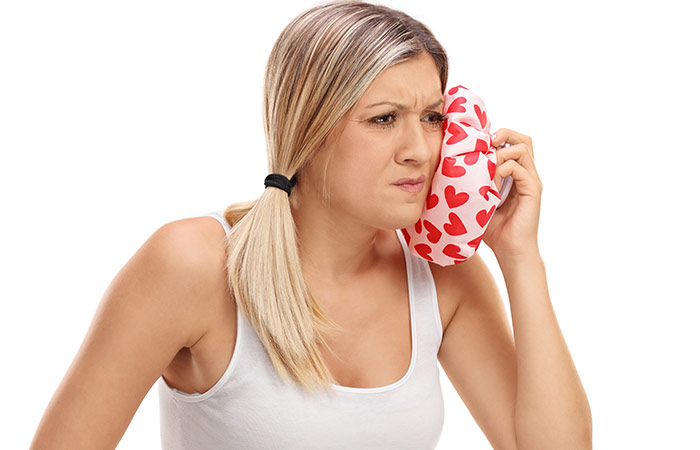Ramona Sinha
There may or may not be quick fixes to deal with issues in your life, but there’s one to deal with acne – an ice cube.
This is the simplest acne and pimple treatment that you can try at home. It is effective in soothing redness and reducing inflammation without any side effects. No, it will not make your acne or pimple disappear magically, but it can facilitate healing. Scroll down to learn how putting an ice cube on a pimple can help.
Table Of Contents
- Ice For Acne: Does An Ice Cube Help Heal Acne And Pimples?
- How To Apply Ice On Acne Or Pimples For Quick Relief
- Things To Know Before Applying Ice On Acne Or Pimples
Ice For Acne: Does An Ice Cube Help Heal Acne And Pimples?
Using cold treatment for healing acne is not new. This idea was conceived in 1925 by Giraudeau. He proposed using acetone, carbon dioxide snow, along with sulfur for treating acne (1). An English physician, James Arnott, advocated using cold treatment for relieving acne (2). Ice therapy has incredible benefits for acne – and they are discussed below:
1. It Reduces Swelling And Inflammation
Sounds promising. Redness and swelling can be an absolute nightmare when you are dealing with cystic acne. When you apply ice on the acne or pimple, it constricts the blood vessels and reduces inflammation (3). Ice has a numbing effect on your skin and slows down the blood flow. This gives you instant relief.
2. It Helps In Shrinking Pores
One of the main causes of acne is clogging of skin pores due to the accumulation of dirt and dead skin cells. Further bacterial invasion gives rise to acne in those areas. Ice packs help in tightening the skin pores so that bacteria and other irritants cannot clog them.
Putting ice on your acne can only help if it is a case of inflammatory acne. This means you will get relief if you put ice on papules, cysts, nodules, and pustules.
Ice will not work on non-inflammatory acne. In other words, it won’t work on your blackheads and whiteheads.
Before you put ice on your face, it is important to learn how to use it – because ice can burn your skin and increase the irritation if you do not apply it in the right way.
How To Apply Ice On Acne Or Pimples For Quick Relief
Avoid applying ice directly to your face. Here are a few ways you can follow for safe application:
1. Make An Ice Pack
Wrap the ice cubes in a towel or put them inside a sandwich bag (if you have one). You can also use a cotton cloth to wrap a single cube. Rub it on the affected area for about 10 minutes. Take a break for 3-4 minutes and then reapply. Make sure you never use ice on your skin for more than 20 minutes.
2. Incorporate Ice Or Cold Water Into Your Skin Care Regimen
If your acne is mild, you may skip the ice cube. Using cold water on your face can have similar effects. Splash cold water on your face in the morning and evening. A gentle cleanser is enough to keep your skin clean.
However, you can always use ice packs on mild acne. Apply a cold compress on your skin for 5 minutes before going to bed.
3. Make An Infusion
You can mix water, a few drops of lemon juice, and a few drops of tomato juice and then freeze it. Rub the ice cube on the affected area.
You can also brew some tea (use green or chamomile teas) and then freeze it. Rub the frozen tea cubes on your face.
4. Dip Your Face In Ice Water
Take cold water in a bowl. Add ice cubes to it. You can even add chunks of lemon and cucumber to the water. Dip your face in the water for a few seconds. Repeat the process for 2 or 3 minutes.
Things To Know Before Applying Ice On Acne Or Pimples
- When you apply ice on acne, it might cause the pus to move up to the surface. Though it may be tempting to pop it, avoid doing so because popping acne or pimples can worsen the inflammation and may even cause scarring.
- Be careful with ice. If you keep it on your skin for too long, it might give you frostbite. Hence, apply it at short intervals.
- Consult a doctor if you notice any adverse effects such as redness and numbness in the affected area.
- When rubbing ice, be gentle. Any friction or irritation can aggravate the acne.
- If you are using a hot compress (to open the skin pores), always use it before using ice on your face. Never use a warm compress after applying ice as it might damage the skin further.
Acne is troublesome – and that’s why you need to be patient. Give your skin some time to recover. While ice treatment can provide you with instant or temporary relief, it is not the only thing you should rely on for treating your acne. Check your lifestyle habits, talk to your doctor, and act accordingly.
Now that you know how to use ice for your acne, try it out. Don’t forget to share your experience with us in the comments section below.
References
- “Treatment of Acne Vulgaris…” JAMA Dermatology
- “The history of cryosurgery” Journal of The Royal Society of Medicine, US National Library of Medicine.
- “Effect of cold on the blood vessel wall.” General Pharmacology, US National Library of Medicine.
Recommended Articles:
- Cosrx Acne Pimple Master Patch Review
- Acnes Clearing Point Anti Pimple Gel Uses
- How To Use Innisfree Bija Cica Balm?


